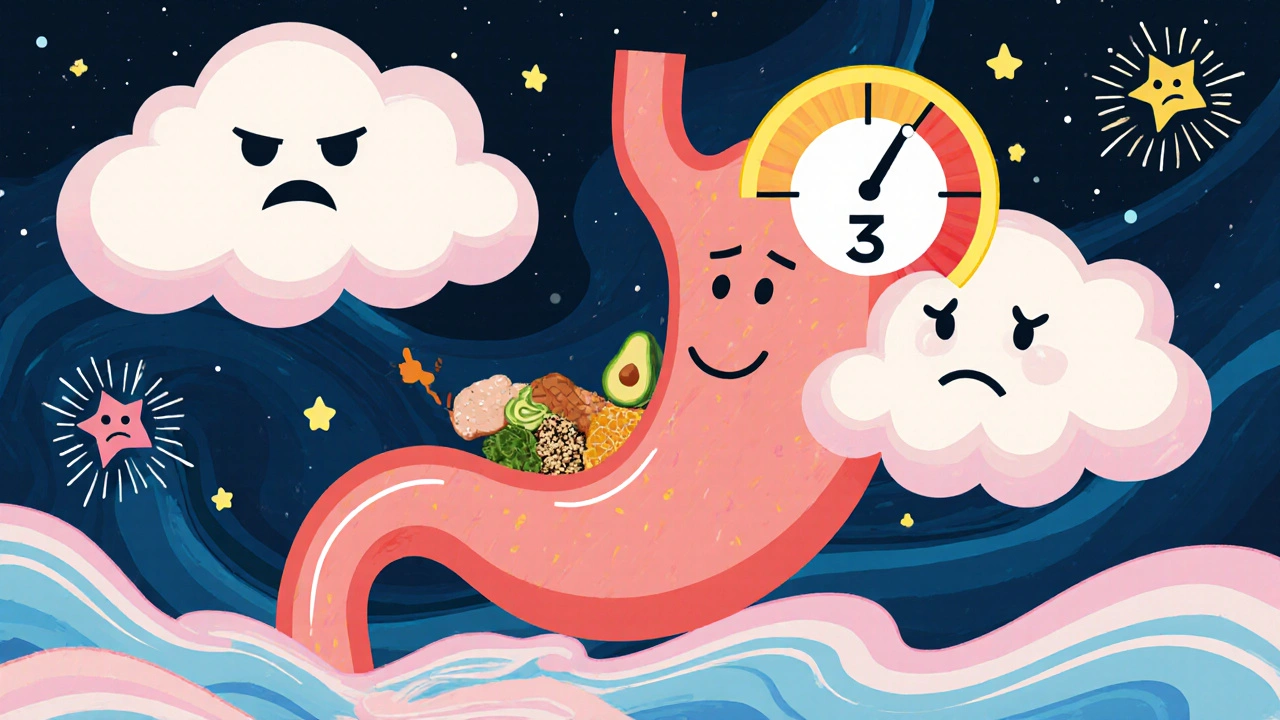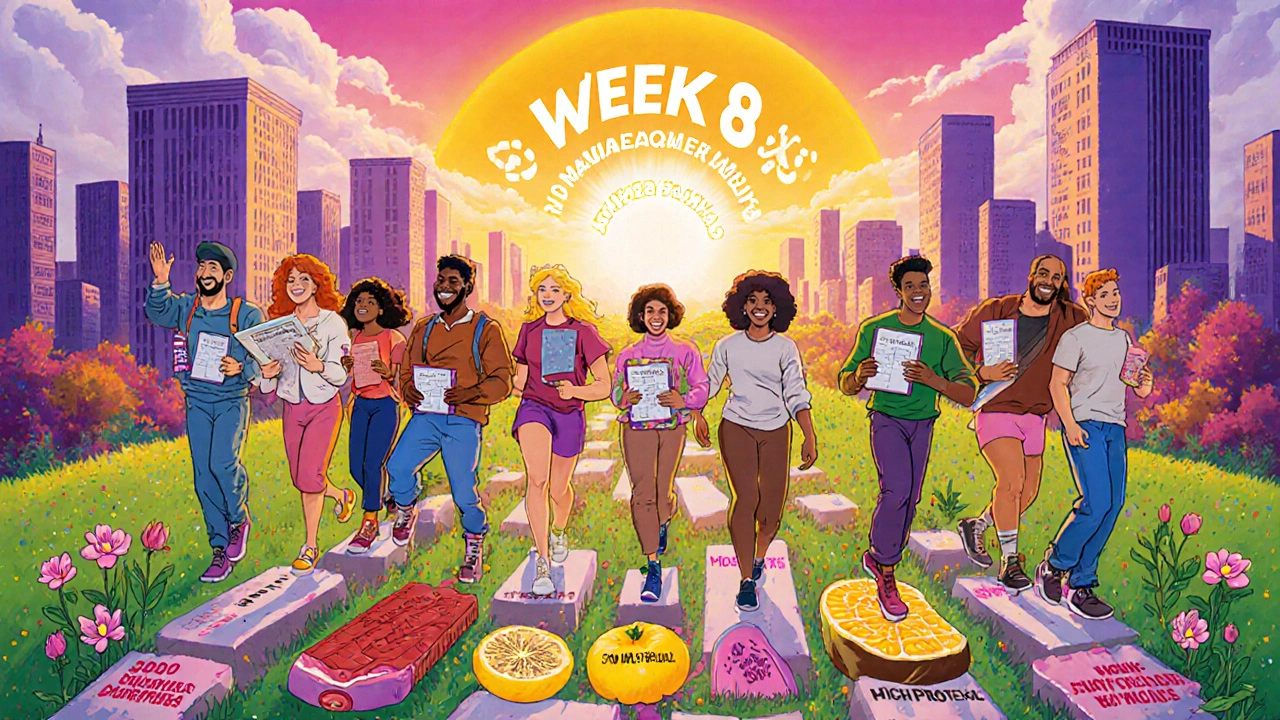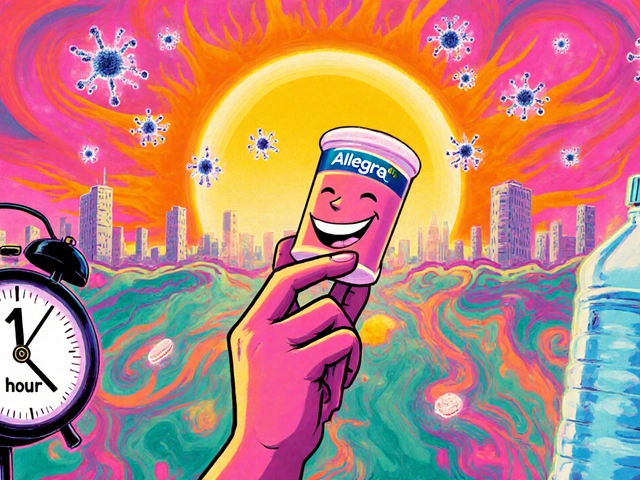GLP-1 Dose Titration Calculator
How Your Body Is Tolerating GLP-1
Rate your symptoms on a scale from 0 (no symptoms) to 10 (severe symptoms). Use this to determine your safe dose increase.
More than 10 million people in the U.S. are now using GLP-1 receptor agonists like Ozempic, Wegovy, or Trulicity for diabetes or weight loss. But for nearly half of them, the journey starts with nausea, vomiting, or bloating - and for 1 in 5, it ends with them quitting the medication altogether. The problem isn’t the drug. It’s how and when they eat, and how fast they increase the dose.
Why GLP-1 Medications Cause GI Problems
GLP-1 drugs slow down how fast your stomach empties. That’s why you feel full longer and lose weight. But it also means food sits in your stomach longer, triggering nausea, bloating, and sometimes vomiting. These side effects aren’t random - they’re directly tied to the drug’s mechanism. A 2023 review found that 40% to 70% of users experience GI issues, with nausea being the most common. For some, it’s mild. For others, it’s so bad they stop taking the medicine.It’s not just about the dose. The timing matters too. Short-acting drugs like Byetta cause more nausea and vomiting early on. Longer-acting ones like semaglutide (Wegovy) or dulaglutide (Trulicity) are more likely to cause diarrhea later. But here’s the good news: most of these symptoms fade over time. By week 8, nausea drops by more than half. By week 56, it’s down to around 5.5% of users.
How to Titrate Doses Without Making Yourself Sick
Doctors often follow a fixed schedule: increase the dose every 4 weeks. But that’s not always the right approach. The best strategy? Let your body tell you when it’s ready.Here’s what works in real life:
- Wait until nausea is gone for at least 7 straight days before increasing the dose.
- If you vomit more than twice in a week, hold the dose for 7 to 10 days. Then restart at the previous level.
- If symptoms stick around for more than 2 weeks, pause for 4 weeks before trying again.
- For people with a history of stomach issues, extend the full titration period to 20-24 weeks instead of 16.
A 2023 study in Diabetes, Obesity and Metabolism showed that people who used this symptom-guided method had 37% fewer dropouts than those who rushed through the schedule. The American Diabetes Association now recommends a GLP-1 GI Tolerance Score - a simple 0 to 10 scale - to help patients and providers decide when to move forward. If your score is above 4, don’t increase the dose.
Also, consider timing your injection. Many users report less nausea when they take their weekly shot in the morning instead of at night. One study found a 25-30% drop in symptoms with morning dosing.
What to Eat (and What to Avoid) During Titration
The biggest mistake people make? Trying to eat like they used to. A GoodRx analysis of 10,000 patient reviews found that 82% of those who quit in the first 8 weeks were eating meals over 600 calories. That’s too much for a slowed-down stomach.Here’s what successful users do:
- Keep meals between 300-400 calories during the first 4-8 weeks.
- Get 25-30 grams of protein in every meal - eggs, chicken, tofu, Greek yogurt, or lean fish.
- Limit fat to under 15 grams per meal. Avoid fried foods, creamy sauces, and full-fat dairy.
- Don’t eat more than 20 grams of simple carbs at once. That means no sugary snacks, white bread, or fruit juice.
- Stick to complex carbs: oats, quinoa, sweet potatoes, legumes.
- Avoid drinking more than 120-180ml (4-6 oz) of liquid with meals. Water is fine. Skip soda, juice, and even large glasses of water.
One Reddit user with 125,000+ followers shared a simple rule: “Eat 20-25g protein within 30 minutes of waking. Then eat small meals every 3-4 hours. No big dinners.” That alone cut their daily nausea to once a week.
Another common trick? Eat 2 hours after your injection. Many users report that waiting helps their stomach adjust before food arrives.

What to Do When Nausea Hits
If you feel sick after your first dose, don’t panic. Here’s a step-by-step plan:- Start with clear liquids: water, broth, or electrolyte drinks. Stick with this for 24-48 hours.
- Move to bland, easy-to-digest foods: toast, rice, bananas, applesauce (the BRAT diet). Eat small bites every 2-3 hours.
- Don’t force yourself to eat if you’re nauseous. Skip a meal. Try again later.
- Wait until you’ve gone 24 hours without vomiting before trying solid foods.
- When you do eat, stick to the 300-400 calorie, high-protein rule.
The Cleveland Clinic found that patients who followed this protocol were 32% less likely to end up in the ER for dehydration. And if vomiting continues for more than 48 hours, contact your doctor. You might need a temporary hold or a lower dose.
Why Most People Quit - And How to Avoid It
The truth? Most people don’t quit because the drug doesn’t work. They quit because they weren’t prepared for the side effects. A Novo Nordisk study found that 65% of dropouts were due to GI issues. But here’s the key insight: those who stuck with it for 6 months were 80% more likely to keep losing weight and keep their blood sugar under control.Companies are catching on. Novo Nordisk now includes free access to a registered dietitian for the first 6 months with Wegovy. Eli Lilly offers biweekly nurse check-ins for Mounjaro users. Both report 15-20% higher adherence rates.
You don’t need a fancy program. Just follow these three rules:
- Slow down the dose increase - let your body lead.
- Keep meals small, protein-rich, and low in fat and sugar.
- Drink fluids between meals, not with them.
One patient told her doctor: “I thought I had to eat less to lose weight. Turns out, I just had to eat differently.”

What’s Next? The Future of GLP-1 Management
Researchers are testing new tools to make this easier. Verily Life Sciences is piloting an app that tracks your nausea, vomiting, and food intake - then suggests the best time to increase your dose. Early results show a 28% drop in discontinuations.Washington University is studying “gut training” - slowly increasing meal size over weeks to help the stomach adapt. Early data shows a 40% reduction in persistent nausea.
For now, the best advice remains simple: don’t rush. Don’t overeat. Don’t ignore your body’s signals. The drug works. Your stomach just needs time to catch up.
How long do GLP-1 GI side effects last?
Most nausea and vomiting peak around week 4 and start improving by week 8. By week 56, only about 5.5% of users still report daily nausea. Diarrhea and constipation may last longer but usually stabilize within 3-6 months. The key is patience - symptoms are temporary for 95% of users.
Can I drink alcohol while on GLP-1 medication?
It’s best to avoid alcohol during the first 8-12 weeks of treatment. Alcohol irritates the stomach and can worsen nausea and vomiting. Even after side effects fade, alcohol slows digestion further and may increase the risk of low blood sugar. If you choose to drink later, limit it to 1 serving and always eat food with it.
Should I take GLP-1 medication with food?
No. Take your GLP-1 shot on an empty stomach, preferably in the morning with just water. Wait 30-60 minutes before eating your first meal. Taking it with food doesn’t help side effects - it can make them worse by confusing your stomach’s timing.
Is it safe to skip a dose if I feel sick?
Yes, if you’re vomiting or too nauseated to eat. Missing one dose won’t undo your progress. Don’t double up later. Just resume your next scheduled dose when you feel better. If symptoms last more than 48 hours, contact your provider. Holding the dose temporarily is safer than pushing through severe side effects.
Can I switch from one GLP-1 drug to another if side effects are bad?
Sometimes. Liraglutide (Saxenda) tends to cause less nausea during initial titration than semaglutide. Dulaglutide (Trulicity) may cause less vomiting but more diarrhea. Switching isn’t always necessary - many people tolerate a different drug better after adjusting their meals and titration pace. Talk to your doctor before switching - it’s often easier to adapt than to change medications.
What if I’m losing too much weight too fast?
If you’re losing more than 1-2 pounds per week and feel weak, dizzy, or fatigued, you may need to adjust your calorie intake. Increase protein slightly and add healthy fats like avocado or nuts in small amounts. Don’t reduce your GLP-1 dose unless advised by your doctor. Rapid weight loss is common and often temporary - but your body still needs fuel to function.




